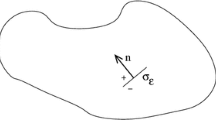Abstract
In this paper the accuracy of the second directional derivative edge detector is analyzed, based on a number of idealized edge models. The results are compared with those for the Laplacian edge detector. Errors are shown to be small under a number of conditions. These conditions are less severe for the second directional derivative than for the Laplacian edge detector. Spurious or phantom edges can be removed by checking the sign of the third directional derivative, though this is not enough to remove all large errors. Indeed, it is also shown that large errors will be obtained if no threshold is set on the magnitude of a third order derivative.
Similar content being viewed by others
References
V. Berzins, “Accuracy of Laplacian Edge Detectors,”Comput. Vision, Graphics, Image Processing, vol. 27, 1984, pp. 195–210.
R.A. Haralick, “Digital Step Edges from Zero Crossings of Second Directional Derivatives,”IEEE Trans. Pattern Anal. Mach. Intell., vol. PAMI-6, 1984, pp. 58–68.
J.J. Clark, “Authenticating Edges Produced by Zero-Crossing Algorithms,”IEEE Trans. Pattern Anal. Mach. Intell., vol. PAMI-11, 1989, pp. 43–57.
J. Canny, “A Computational Approach to Edge Detection,”IEEE Trans. Pattern Anal. Mach. Intell., vol. PAMI-8, 1986, pp. 679–698.
S. Sarkar and K.L. Boyer, “Optimal Infinite Impulse Response Zero Crossing Based Edge Detectors,”Comput. Vision, Graphics, Image Processing, vol. 54, 1991, pp. 224–243.
S. Sarkar and K.L. Boyer, “On Optimal Infinite Impulse Response Edge Detection Filters,”IEEE Trans. Pattern Anal. Mach. Intell., vol. PAMI-13, 1991, pp. 1154–1171.
D. Marr and E. Hildreth, “Theory of Edge Detection,”Proc. Roy. Soc. London Ser. B, vol. 207, 1980, pp. 187–217.
M.A. Piech, “Decomposing the Laplacian,”IEEE Trans. Pattern Anal. Mach. Intell., vol. PAMI-12, 1990, pp. 830–831.
V.S. Nalwa and T.O. Binford, “On Detecting Edges,”IEEE Trans. Pattern Anal. Mach. Intell., vol. PAMI-8, 1986, pp. 699–714.
A. Rosenfeld and A. Kak,Digital Picture Processing, New York: Academic Press, 1982.
J.A. De Vriendt, “The Matching Problem: Heuristic Approach Considering both Split and Merge Competition,” inProc. IEE Fourth Int. Conf. Image Processing, Maastricht, The Netherlands, pp. 53–56.
J.A. De Vriendt, “Derivation of the Third Order Directional Derivative,”Pattern Recognition Letters, accepted.
T. Vieville and O. Faugeras, “Robust and Fast Computation of Unbiased Intensity Derivatives in Images,” inProc. 2nd European Conf. Computer Vision, Lecture Notes in Computer Science, vol. 588, Berlin, Heidelberg, New York: Springer-Verlag, pp. 203–211, 1992.
A. Heurtas and G. Medioni, “Detection of Intensity Changes with Subpixel Accuracy Using Laplacian-Gaussian Masks,”IEEE Trans. Pattern Anal. Mach. Intell., vol. PAMI-8, 1986, pp. 651–664.
Author information
Authors and Affiliations
Additional information
This work was supported by the Belgian National Fund for Scientific Research (NFWO).
Rights and permissions
About this article
Cite this article
de Vriendt, J. Accuracy of the zero crossings of the second directional derivative as an edge detector. Multidim Syst Sign Process 4, 227–251 (1993). https://doi.org/10.1007/BF00985890
Received:
Revised:
Issue Date:
DOI: https://doi.org/10.1007/BF00985890




